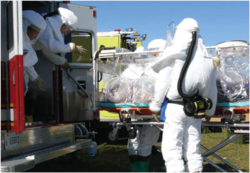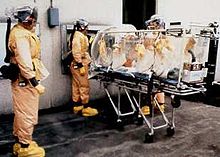Aeromedical Isolation Team

The Aeromedical Isolation Team (AIT, or SMART-AIT) of the
US Air Force’s Critical Care Air Transport Teams
(CCATTs).
History

The AIT was created in 1978 for purposes of contingency
Throughout its existence the AIT was associated with a
U.S. Department of State. Occasionally, the AIT trained with similar teams of foreign allies.[5]
This section needs expansion. You can help by adding to it. (May 2012) |
In 2007, due to the death of Mr Roberts, the ATI and associated products ceased to be manufactured. During 2008–2010, the AIT began preliminary training with, and testing of, a new transit isolator product — the Patient Isolation Unit (PIU) — developed by the Gentex Corporation under a contract with the U.S. Air Force.
The AIT was decommissioned — along with the MCS — in 2010 and its mission was assumed by one of the
patient isolation
. No BSL-4 ICU facility has replaced the Army's former MCS to date.
Selected AIT alerts and deployments
- Deployed to Reston, Virginia, Ebola outbreak, 1989
- Deployed to Sweden in support of Marburg virus patient management, 1989[7]
- Alerted for Ebola outbreak in Zaire, 1993
- On call for Sabia virusexposure, 1994
- Alerted for military physician Machupo virusexposure, 1994
- Alert for Ebola, Zaire outbreak, 1995
- Deployed to Wright-Patterson AFB, Bio-bomblets, Dec 1995[citation needed]
- Alerted for deployment to Rwanda/Zaire 1996
- NYC, Bronx Zoo, West Nile virus, Oct 1999
- Alerted to support with possible Ebola exposure in Uganda, Dec 2000
- Alerted for support with anthrax mailings, 2001
- Alerted to support WTC attacks, 2001
- On orders to support the Presidential State of the Union Address, 30 January 2002
- On orders to support the Winter Olympics, 17 January to 20 March 2002
- Advisors for SARS outbreak, 2003
- Alerted for XDR-TBpatient, May 2007
- Alerted for Viral hemorrhagic fever outbreak in Congo, Aug 2007
See also
- United States biological defense program
- List of former United States Army medical units
- Aeromedical Biological Containment System
References
- Emerg Infect Dis, 1999: Mar-Apr; 5(2): 241–246.
- ^ Marklund, LeRoy A., “Patient care in a biological safety level-4 (BSL-4) environment”; Crit Care Nurs Clin N Am: 15 (2003), 245– 255.
- ^ a b Sidell, Frederick R.; Takafuji, Ernest T.; Franz, David R., D.V.M. (1997). "19". Medical Aspects of Chemical and Biological Warfare. Office of The Surgeon General Department of the Army, United States of America. Archived from the original on 26 April 2005. Retrieved 15 April 2015.
{{cite book}}: CS1 maint: multiple names: authors list (link) - Aviat Space Environ Med, 1979: Oct;50(10):1067-72.
- ^ Fleming-Michael, Karen (2005), “Training Day” Archived October 30, 2014, at the Wayback Machine, Fort Detrick Standard (28 Sep 2005 issue).
- U.S. Government Printing Office, pp 45-58.
- ^ Covert, Norman M. (1993), Cutting Edge: A History of Fort Detrick, Maryland, 1943-1993, Headquarters, U.S. Army Garrison, Fort Detrick, Maryland, pg 81.
